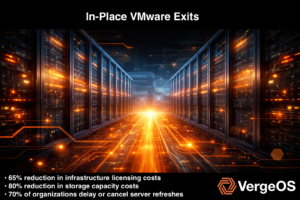
Many VMware customers are concerned about ever-increasing licensing costs, and are actively considering VMware alternatives. However, mitigating VMware migration risks is an even more significant concern. There are four steps that IT planners can take to ensure a seamless and risk-free migration to a new infrastructure platform:
- Upfront Assessment
- Virtual Proof of Concept
- On-Premises Evaluation
- Gradual Cut Over
Upfront Assessment of a VMware Alternative
Before diving deep into any IT project, you want to ensure the result will be significantly better than the current state. When considering a VMware alternative, reducing and simplifying licensing costs is one of the obvious areas to examine. Beyond licensing costs, IT should also evaluate long-term cost savings potential like:
- Simplifying day-to-day operations like patching.
- Extending the life of existing hardware and using it more efficiently.
- Eliminating the need for a dedicated storage array.
Additionally, moving to an alternative platform should deliver more than cost savings. IT planners should consider the move to a new platform as an opportunity to improve capabilities like:
- Improving data protection capabilities by moving beyond snapshots.
- Improving ransomware resiliency and detection with a hardened infrastructure platform.
Finally, before moving to the next step, you should talk to some existing customers and see what they have to say about the potential alternative. Get their feedback on how easy the product is to use, how well it’s supported, and learn about their day-to-day experiences. Current customers can prove vendor claims.
Virtual Proof of Concept of a VMware Alternative
Once IT completes its initial assessment, most vendors try to rush to a proof of concept (POC). POCs are the cornerstone of mitigating VMware migration risks, but the problem is that a POC requires IT to find some hardware or make space for the vendor’s hardware. It also means that IT must find the time to go through the testing process and have a strategy for performing that test.

An alternative is a virtual proof of concept, where the vendor creates a virtual environment for you to test drive their solution. However, this virtual environment must give you full reign to perform whatever type of testing you want. You should be able to do more than “just drive the GUI.” You should be able to load up your virtual machines (VMs), test data protection capabilities, and start to think through on-premises test plans.
Your virtual instance should be 100% isolated from any other virtual POCs. Otherwise, you can’t deploy your applications and data without the risk of another organization gaining access to them. If the vendor can only deliver that isolation by dedicating specific hardware for the test, they will likely have to limit the time you can test. If the vendor can deliver that isolation, then they should be able to provide a very flexible testing timeframe.
On-Premises Evaluation of a VMware Alternative
If the potential VMware alternative still interests you after completing the virtual proof of concept, it is then time to move to an on-premises evaluation of the solution. Most vendors are happy to provide an on-premises evaluation. Still, the IT planner must pay attention to the vendor’s behavior as you move through this process.
There are red flags that will appear, even before you start testing. These red flags should give you some insight into how well the solution is going to perform for you in the coming years:
? Does the vendor require a multi-hour meeting to ensure all the technical requirements are met?
? Does the vendor insist on providing you with hardware even though they say they are "software-only"?
? Does the vendor want to come on-site to install the evaluation?
? Does the vendor push you to do a "try-and-buy" where you commit to buying the solution if critical requirements are met?
? Does the vendor insist you use the local technical resource for any technical questions that might arise?An on-premises evaluation should be a strings-free relationship. You should be able to use existing hardware. It should only require a quick call, not a three-hour workshop, to ensure the hardware you plan to use is optimal for your testing. If the vendor claims to be software-only, then as long as you can provide hardware that meets their minimum requirements, you should be given the green light for your evaluation.
Usually, having a vendor come on-site to install an evaluation, or worse, providing you with a “turnkey” hardware package for the evaluation is a sign that the vendor is trying to hide how complex their solution is to get running. If it is hard to install, it will be hard to operate.
You are testing something new, and you will run into technical questions. You should go through regular technical support channels to get those questions answered. This process lets you see what kind of support you will get years after installation.
Gradual Cut-Over to the New Platform
Once you’ve completed the evaluation, you should map out a migration strategy before you commit to purchase. Mitigating VMware migration risks requires that the cut-over to the new platform is gradual. In most cases, you won’t flip a switch and, in a single pass, move all your VMs to the new platform. You typically migrate in “lumps,” one workload at a time. This more gradual process means the migration capabilities, if there are any, should be continuous. The new platform’s migration capabilities need to keep VMs from the VMware environment in sync so that the most recent copy of data is on the new platform when IT is ready to convert the next workload.
A near-continuous sync of VMware VMs to the new platform also means that it can provide enterprise-wide value from day one while you are gradually migrating to it. Suppose the migration function is near-continuous and intelligent enough only to move changed data blocks. In that case, it can act as a disaster recovery solution (DR) for the entire VMware environment. The result is from day one; it can save you money while you migrate at your pace. Without it, you are under too much pressure to show value from the new purchase quickly, making you more likely to rush VM migrations.
If the new platform achieves the efficiency mentioned in the initial assessment, IT should be able to carve off two or three physical servers to act as the initial foundation. Those initial servers should be able to receive all the migrated VMs and the continuous updates to them. Then, as you move VMs into production on the new platform, resources will free up in the VMware environment, enabling you to add a few more servers to the new platform.
A De-Risked VMware Migration
Selecting a vendor that is patient enough to walk through the above process de-risks the migration away from VMware. Each of these steps is essentially a checkpoint in the process, and you don’t move to the next step until you are confident in the results of the prior step.
Using existing hardware and providing value while you migrate are critical. If, during the evaluation process, you discover something you don’t like about the solution, you are not saddled with a bunch of hardware that you must de-install and return. And the ability to add value while you gradually migrate, in our example acting as a DR solution, puts less pressure on you to migrate too quickly.
The VergeIO Team is happy to guide you through this process, which is why we have such high customer satisfaction. The first step is to perform the upfront assessment—schedule yours now with one of our technical experts.


